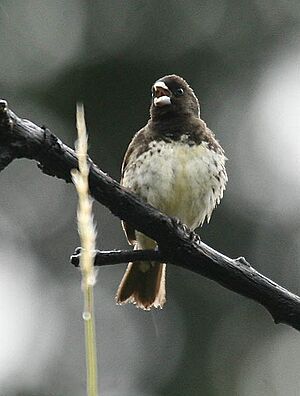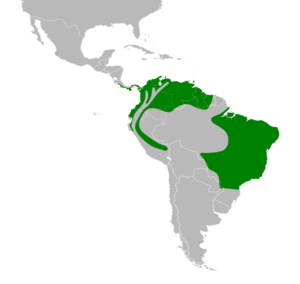Yellow-bellied seedeater facts for kids
Quick facts for kids Yellow-bellied seedeater |
|
|---|---|
 |
|
| Male in Ecuador | |
| Conservation status | |
| Scientific classification | |
| Genus: |
Sporophila
|
| Species: |
nigricollis
|
 |
|
| Synonyms | |
|
|
The yellow-bellied seedeater (Sporophila nigricollis) is a small, colorful bird. It is known for its bright yellow belly, which gives it its name. This bird belongs to the Thraupidae family, which includes many types of tanagers.
Contents
About the Yellow-Bellied Seedeater
A Bird with a Special Look
The yellow-bellied seedeater is a small bird. The male birds often have a black head and upper chest. Their back is usually olive-colored, and their belly is a clear, pale yellow. Female birds are generally duller in color. They are mostly olive-brown with a lighter belly.
The Mystery of the Hooded Seedeater
Long ago, in 1870, an Austrian bird expert named August von Pelzeln described a bird he called the "hooded seedeater." There was only one known bird like this. It was caught in Brazil in 1823. This bird had a black crest and throat, olive upper parts, and a dull yellowish-brown belly.
However, scientists now believe this "hooded seedeater" was not a separate species. It was likely either a mix of two different bird species (called a hybrid) or a yellow-bellied seedeater that looked a bit unusual. Regular yellow-bellied seedeaters have a brighter yellow belly and more black on their upper chest.
Where Yellow-Bellied Seedeaters Live
Their Home and Habitat
The yellow-bellied seedeater lives in many parts of Central and South America. You can find them from Costa Rica all the way down to Bolivia.
These birds like to live in certain kinds of places. They prefer areas with lots of bushes and shrubs, especially in high-up, tropical regions. They also live in open fields where animals graze (pastureland). Sometimes, they can be found in areas that used to be forests but have changed a lot because of human activity.
Protecting Yellow-Bellied Seedeaters
Challenges They Face
Sadly, yellow-bellied seedeaters face some dangers. One big problem is that many of them are caught illegally. People catch these birds to sell them as pets.
One study in Brazil found that about 16,800 yellow-bellied seedeaters are caught and sold illegally each year. This makes it harder for these beautiful birds to thrive in the wild.


